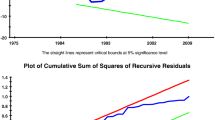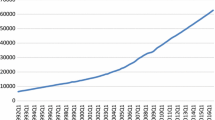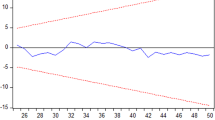Abstract
In this study, the relationship between electricity and growth of the economy is investigated by applying the newly-developed bootstrap autoregressive-distributed lag test with a Fourier function to examine both the causality and cointegration for China, India, and the United States (US). While it is not possible to detect a long-term cointegration relation among the economy's electricity and growth, the study findings demonstrate the contingency of the causality. The ensemble method in machine learning performs better than conventional methods as electricity is an independent indicator for forecast economics. Concerning the US, previous electricity consumption has a positive impact on the current nature of economic growth. In contrast, the consumption of electricity is negatively affected by the development of the economy. However, for China and India, positive and negative feedback can be observed, respectively. Due to the increased awareness of the environment's adverse effects, China should promote technologies that conserve energy and boost energy efficiency to achieve sustainable development in both environmental and economic terms. In India's context, broadening access to electricity has significance for residents in rural areas and enhances economic growth. It is recommended that policy-makers promote innovative technologies in the US, as the abundant natural and human resources can make valuable contributions to the society and development of the economy.

Similar content being viewed by others
References
Aastveit, M. E. (2019). Predicting recessions using boosting and Bayesian model averaging. Thesis for the degree of Master in Economic Theory and Econometrics. University of Oslo.
Akalpler, E., & Hove, S. (2019). Carbon emissions, energy use, real GDP per capita and trade matrix in the Indian economy-an ARDL approach. Energy, 168, 1081–1093.
Al-Mulali, U., Solarin, S. A., & Ozturk, I. (2016). Biofuel energy consumption-economic growth relationship: An empirical investigation of Brazil. Biofuels, Bioproducts and Biorefining, 10(6), 753–775.
Amri, F. (2017). The relationship amongst energy consumption (renewable and non-renewable), and GDP in Algeria. Renewable and Sustainable Energy Reviews, 76, 62–71.
Ashin-Nishan, M. K. (2020). Role of energy use in the prediction of CO2 emissions and economic growth in India: Evidence from artificial neural networks (ANN). Environmental Science and Pollution Research 1–12.
Asumadu-Sarkodie, S., & Owusu, P. A. (2016). Carbon dioxide emissions, GDP, energy use, and population growth: A multivariate and causality analysis for Ghana, 1971–2013. Environmental Science and Pollution Research, 23(13), 13508–13520.
Bah, M. M., & Azam, M. (2017). Investigating the relationship between electricity consumption and economic growth: Evidence from South Africa. Renewable and Sustainable Energy Reviews, 80, 531–537.
Bastola, U., & Sapkota, P. (2015). Relationships among energy consumption, pollution emission, and economic growth in Nepal. Energy, 80, 254–262.
Becker, R., Enders, W., & Lee, J. (2006). A stationarity test in the presence of an unknown number of smooth breaks. Journal of Time Series Analysis, 27(3), 381–409.
Benkraiem, R., Lahiani, A., Miloudi, A., & Shahbaz, M. (2019). The asymmetric role of shadow economy in the energy-growth nexus in Bolivia. Energy Policy, 125, 405–417.
Berge, T. J. (2015). Predicting recessions with leading indicators: Model averaging and selection over the business cycle. Journal of Forecasting, 34(6), 455–471.
Bildirici, M. E. (2016). Biomass energy consumption and economic growth: ARDL analysis. Energy Sources, Part B: Economics, Planning, and Policy, 11(6), 562–568.
Bildirici, M. E., Bakirtas, T., & Kayikci, F. (2012). Economic growth and electricity consumption: Auto regressive distributed lag analysis. Journal of Energy in Southern Africa, 23(4), 29–45.
Bildirici, M. E., & Kayikçi, F. (2016). Electricity consumption and growth in Eastern Europe: An ARDL analysis. Energy Sources, Part B: Economics, Planning, and Policy, 11(3), 258–266.
Bonan, J., Pareglio, S., & Tavoni, M. (2014). Access to modern energy: A review of impact evaluations. SSRN Electronic Journal. Retrieved July 28, 2020, https://www.researchgate.net/publication/281438819_Access_to_Modern_Energy_A_Review_of_Impact_Evaluations.
Bonlender, B. (2018). State of the data center industry. State of Washington: Department of Commerce, State of Washington.
Boot, T., & Nibbering, D. (2019). Forecasting using random subspace methods. Journal of Econometrics, 209(2), 391–406.
Boukhelkhal, A., & Bengana, I. (2018). Cointegration and causality among electricity consumption, economic, climatic and environmental factors: Evidence from North-Africa region. Energy, 163, 1193–1206.
Center BP (2020) Annual energy outlook 2020. Energy Information Administration, Washington, DC.
Chandio, A. A., Jiang, Y., Sahito, J. G. M., & Ahmad, F. (2019). Empirical insights into the long-run linkage between households energy consumption and eonomic growth: Macro-level empirical evidence from Pakistan. Sustainability, 11(22), 6291.
Choi, H., Son, H., & Kim, C. (2018). Predicting financial distress of contractors in the construction industry using ensemble learning. Expert Systems with Applications, 110, 1–10.
Christopoulos, D. K., & Leon-Ledesma, M. A. (2011). International output convergence, breaks, and asymmetric adjustment. Studies in Nonlinear Dynamics & Econometrics, 15(3), 1–33.
Cogoljević, D., Alizamir, M., Piljan, I., Piljan, T., Prljić, K., & Zimonjić, S. (2018). A machine learning approach for predicting the relationship between energy resources and economic development. Physica A: Statistical Mechanics and its Applications, 495, 211–214.
Costa-Campi, M. T., García-Quevedo, J., & Trujillo-Baute, E. (2018). Electricity regulation and economic growth. Energy Policy, 113, 232–238.
Dogan, E. (2015). The relationship between economic growth and electricity consumption from renewable and non-renewable sources: A study of Turkey. Renewable and Sustainable Energy Reviews, 52, 534–546.
Enders, W., & Jones, P. (2016). Grain prices, oil prices, and multiple smooth breaks in a VAR. Studies in Nonlinear Dynamics & Econometrics, 20(4), 399–419.
Energy Information Administration. (2020). Annual Energy Outlook 2020 with projections to 2050. Retrieved July 28, 2020, https://www.eia.gov/outlooks/aeo/pdf/AEO2020%20Full%20Report.pdf.
Faisal, F., Tursoy, T., Gunsel Resatoglu, N., & Berk, N. (2018). Electricity consumption, economic growth, urbanisation and trade nexus: Empirical evidence from Iceland. Economic Research-Ekonomska istraživanja, 31(1), 664–680.
Gallant, A. R. (1981). On the bias in flexible functional forms and an essentially unbiased form: The Fourier flexible form. Journal of Econometrics, 15(2), 211–245.
Gallant, A. R., & Souza, G. (1989). On the asymptotic normality of Fourier flexible form estimates. Raleigh: Department of Statistics, North Carolina State University.
Giovanis, E. (2013). Application of stationary wavelet support vector machines for the prediction of economic recessions. International Journal of Mathematical Models and Methods in Applied Sciences, 3(7), 226–237.
Gogas, P., Papadimitriou, T., Matthaiou, M., & Chrysanthidou, E. (2015). Yield curve and recession forecasting in a machine learning framework. Computational Economics, 45(4), 635–645.
Gründler, K., & Krieger, T. (2016). Democracy and growth: Evidence from a machine learning indicator. European Journal of Political Economy, 45, 85–107.
Hassan, S. T., Baloch, M. A., Mahmood, N., & Zhang, J. (2019). Linking economic growth and ecological footprint through human capital and biocapacity. Sustainable Cities and Society, 47, 101516.
Hussain, H. I., Salem, M. A., Rashid, A. Z. A., & Kamarudin, F. (2019). Environmental impact of sectoral energy consumption on economic growth in Malaysia: Evidence from ARDL bound testing approach. Ekoloji, 28(107), 199–210.
IEA. (2019). World energy outlook 2019. Retrieved July 28, 2020, https://www.iea.org/reports/world-energy-outlook-2019/electricity#abstract.
International Renewable Energy Agency. (2015). A renewable energy roadmap-REmap 2030.
International Renewable Energy Agency. (2020). Global renewables outlook-energy transformation 2050.
Jarrett, U., Mohaddes, K., & Mohtadi, H. (2019). Oil price volatility, financial institutions and economic growth. Energy Policy, 126, 131–144.
Kahane, A., & Squitieri, R. (1987). Electricity use in manufacturing. Annual Review of Energy, 12(1), 223–251.
Kahouli, B. (2017). The short and long run causality relationship among economic growth, energy consumption and financial development: Evidence from South Mediterranean Countries (SMCs). Energy Economics, 68, 19–30.
Katırcıoğlu, S., Fethi, S., Kalmaz, D. B., & Çağlar, D. (2016). Interactions between energy consumption, international trade, and real income in Canada: An empirical investigation from a new version of the Solow growth model. International Journal of Green Energy, 13(10), 1059–1074.
Kayıkçı, F., & Bildirici, M. (2015). Economic growth and electricity consumption in GCC and MENA countries. South African Journal of Economics, 83(2), 303–316.
Kordanuli, B., Barjaktarović, L., Jeremić, L., & Alizamir, M. (2017). Appraisal of artificial neural network for forecasting of economic parameters. Physica A: Statistical Mechanics and its Applications, 465, 515–519.
Kozlowski, S. E., & Sim, T. (2019). Predicting recessions using trends in the yield spread. Journal of Applied Statistics, 46(7), 1323–1335.
Kraft, J., & Kraft, A. (1978). On the relationship between energy and GNP. The Journal of Energy and Development, 3, 401–403.
Kumar, R. R., Stauvermann, P. J., & Kumar, N. (2019). Exploring the effect of energy consumption on the economic growth of Albania. Engineering Economics, 30(5), 530–543.
Kumar, R. R., Stauvermann, P. J., Loganathan, N., & Kumar, R. D. (2015). Exploring the role of energy, trade and financial development in explaining economic growth in South Africa: A revisit. Renewable and Sustainable Energy Reviews, 52, 1300–1311.
Kumar, R. R., Stauvermann, P. J., Patel, A., & Kumar, N. (2017). The effect of energy on output per worker in the Balkan Peninsula: A country-specific study of 12 nations in the Energy Community. Renewable and Sustainable Energy Reviews, 70, 1223–1239.
Kyophilavong, P., Shahbaz, M., Kim, B., & Jeong-Soo, O. H. (2017). A note on the electricity-growth nexus in Lao PDR. Renewable and Sustainable Energy Reviews, 77, 1251–1260.
Lee, C. C. (2006). The causality relationship between energy consumption and GDP in G-11 countries revisited. Energy Policy, 34(9), 1086–1093.
Liu, X. (2018). Aggregate and disaggregate analysis on energy consumption and economic growth nexus in China. Environmental Science and Pollution Research, 25(26), 26512–26526.
Ludlow, J., & Enders, W. (2000). Estimating non-linear ARMA models using Fourier coefficients. International Journal of Forecasting, 16(3), 333–347.
Marjanović, V., Milovančević, M., & Mladenović, I. (2016). Prediction of GDP growth rate based on carbon dioxide (CO2) emissions. Journal of COssssssss Utilization, 16, 212–217.
Marković, D., Petković, D., Nikolić, V., Milovančević, M., & Petković, B. (2017). Soft computing prediction of economic growth based in science and technology factors. Physica A: Statistical Mechanics and its Applications, 465, 217–220.
McNown, R., Sam, C. Y., & Goh, S. K. (2018). Bootstrapping the autoregressive distributed lag test for cointegration. Applied Economics, 50(13), 1509–1521.
Milačić, L., Jović, S., Vujović, T., & Miljković, J. (2017). Application of artificial neural network with extreme learning machine for economic growth estimation. Physica A: Statistical Mechanics and its Applications, 465, 285–288.
Nepal, R., & Paija, N. (2019). Energy security, electricity, population and economic growth: The case of a developing South Asian resource-rich economy. Energy Policy, 132, 771–781.
Nguyen, D. K., Sévi, B., Sjö, B., & Uddin, G. S. (2017). The role of trade openness and investment in examining the energy-growth-pollution nexus: Empirical evidence for China and India. Applied Economics, 49(40), 4083–4098.
Nyasha, S., Gwenhure, Y., & Odhiambo, N. M. (2018). Energy consumption and economic growth in Ethiopia: A dynamic causal linkage. Energy & Environment, 29(8), 1393–1412.
Nyman, R., & Ormerod, P. (2017). Predicting economic recessions using machine learning algorithms. arXiv:1701.01428.
Pablo-Romero, M. D. P., Pozo-Barajas, R., & Yñiguez, R. (2017). Global changes in residential energy consumption. Energy Policy, 101, 342–352.
Pata, U. K., & Kahveci, S. (2018). A multivariate causality analysis between electricity consumption and economic growth in Turkey. Environment, Development and Sustainability, 20(6), 2857–2870.
Payne, J. E. (2009). On the dynamics of energy consumption and output in the US. Applied Energy, 86(4), 575–577.
Pesaran, M. H., Shin, Y., & Smith, R. J. (2001). Bounds testing approaches to the analysis of level relationships. Journal of Applied Econometrics, 16(3), 289–326.
Rafindadi, A. A., & Ozturk, I. (2016). Effects of financial development, economic growth and trade on electricity consumption: Evidence from post-Fukushima Japan. Renewable and Sustainable Energy Reviews, 54, 1073–1084.
Rahman, M. M., & Mamun, S. A. K. (2016). Energy use, international trade and economic growth nexus in Australia: New evidence from an extended growth model. Renewable and Sustainable Energy Reviews, 64, 806–816.
Richmond, J., & Urpelainen, J. (2019). Electrification and appliance ownership over time: Evidence from rural India. Energy Policy, 133, 110862.
Sbia, R., Shahbaz, M., & Ozturk, I. (2017). Economic growth, financial development, urbanisation and electricity consumption nexus in UAE. Economic Research-Ekonomska istraživanja, 30(1), 527–549.
Schwert, G. W. (1989). Tests for unit roots: A Monte Carlo investigation. Journal of Business & Economic Statistics, 7(2), 147–159.
Sekantsi, L. P., & Okot, N. (2016). Electricity consumption–economic growth nexus in Uganda. Energy Sources, Part B: Economics, Planning, and Policy, 11(12), 1144–1149.
Sekantsi, L. P., & Thamae, R. I. (2016). Electricity consumption and economic growth in Lesotho. Energy Sources, Part B: Economics, Planning, and Policy, 11(10), 969–973.
Shahbaz, M., Sarwar, S., Chen, W., & Malik, M. N. (2017). Dynamics of electricity consumption, oil price and economic growth: Global perspective. Energy Policy, 108, 256–270.
Sokolov-Mladenović, S., Milovančević, M., Mladenović, I., & Alizamir, M. (2016). Economic growth forecasting by artificial neural network with extreme learning machine based on trade, import and export parameters. Computers in Human Behavior, 65, 43–45.
Stern, D. I. (2000). A multivariate cointegration analysis of the role of energy in the US macroeconomy. Energy Economics, 22(2), 267–283.
Wada, I. (2017). Dynamic causality in energy production and output growth in Nigeria revisited: ARDL bounds test approach. Energy Sources, Part B: Economics, Planning, and Policy, 12(11), 945–951.
Wang, Q., Su, M., Li, R., & Ponce, P. (2019). The effects of energy prices, urbanization and economic growth on energy consumption per capita in 186 countries. Journal of Cleaner Production, 225, 1017–1032.
Wang, S., Li, Q., Fang, C., & Zhou, C. (2016). The relationship between economic growth, energy consumption, and CO2 emissions: Empirical evidence from China. Science of the Total Environment, 542, 360–371.
Wu, C. F., Wang, C. M., Chang, T., & Yuan, C. C. (2019). The nexus of electricity and economic growth in major economies: The United States-India-China triangle. Energy, 188, 116006.
Xin-gang, Z., & Pei-ling, L. (2020). Is the energy efficiency improvement conducive to the saving of residential electricity consumption in China? Journal of Cleaner Production, 249, 119339.
Yilanci, V., Bozoklu, S., & Gorus, M. S. (2020). Are BRICS countries pollution havens? Evidence from a bootstrap ARDL bounds testing approach with a Fourier function. Sustainable Cities and Society, 55, 102035.
Zhong, X., Jiang, H., Zhang, C., & Shi, R. (2019). Electricity consumption and economic growth nexus in China: An autoregressive distributed lag approach. Environmental Science and Pollution Research, 26(14), 14627–14637.
Zhou, X., Zhang, M., Zhou, M., & Zhou, M. (2017). A comparative study on decoupling relationship and influence factors between China’s regional economic development and industrial energy–related carbon emissions. Journal of Cleaner Production, 142, 783–800.
Zivot, E., & Andrews, D. W. K. (2002). Further evidence on the great crash, the oil-price shock, and the unit-root hypothesis. Journal of Business & Economic Statistics, 20(1), 25–44.
Acknowledgements
We thank the anonymous reviewers for their careful reading of our manuscript and their many insightful comments and suggestions. We thank resources from Research Center of Hubei Logistics Development, Hubei University of Economics, and Wuchang University of Technology.
Funding
Hubei University of Economics with the grant number of XJ201901; XJ201902;11024225.
Author information
Authors and Affiliations
Contributions
C-FW contributed to the research topic, model, data collection, coding, and writing. S-CH contributed to the literature reviewing, writing, and developed implications. C-CC edited this manuscript, developed implications, and responsible for correspondence. TC and Y-CC contributed to results analysis, literature reviewing, and editing.
Corresponding author
Ethics declarations
Conflict of interest
The authors declare that they have no known competing financial interests or personal relationships that could have appeared to influence the work reported in this paper.
Ethical Approval
This article uses secondary data, does not involve the ethical issues of human behavior research, and does not require ethical approval.
Informed Consent
This article uses secondary data, does not involve the ethical issues of human behavior research, and does not require informed consent.
Additional information
Publisher's Note
Springer Nature remains neutral with regard to jurisdictional claims in published maps and institutional affiliations.
Rights and permissions
About this article
Cite this article
Wu, CF., Huang, SC., Chiou, CC. et al. The Relationship Between Economic Growth and Electricity Consumption: Bootstrap ARDL Test with a Fourier Function and Machine Learning Approach. Comput Econ 60, 1197–1220 (2022). https://doi.org/10.1007/s10614-021-10097-7
Accepted:
Published:
Issue Date:
DOI: https://doi.org/10.1007/s10614-021-10097-7
Keywords
- Fourier approximation
- Structural breaks
- Bootstrap autoregressive-distributed lag (ARDL)
- Cointegration
- Causality
- Machine learning




